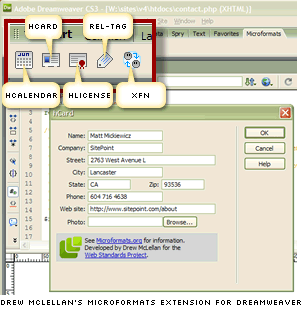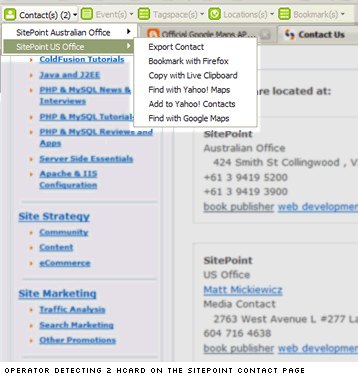I must admit, when the concept of Microformats first starting frothing on the conference circuit, I was a little bit underwhelmed. Sure, I can see the potential value in the idea — making it easy transfer useful data (event times, contact details, etc) from the web to other devices. Sounds peachy.
Incorporating them into a site was never a big issue. The markup does tend towards the mind-numbing, but all the most popular formats now have push button generators (hCard, hCalendar, hReview) that do most of the grunt work for you.
No, for me the question was ‘Great! But what have they done for me lately?‘
Mostly this was met with an extended ‘Well…….once upon a time, in a galaxy, far, far away…‘ and some concentrated carpet scuffing. While I spent some time coding microformats into my pages, for me it felt a bit like buying carbon offset credits — the ‘honorable’ thing to do, but part of me couldn’t shake the idea I was getting scammed.
Perhaps that’s beginning to change.
Google Maps this week joined Yahoo Maps in natively reading and writing the hCard microformat — the microformat dedicated to describing people and organizations. Now, while this adds some handy functionality to the Google maps service, it’s really how this effects your pages that’s starting to make Microformats look useful in a day-to-day kind of way.
Firstly, the bad bit. Currently no browser can usefully use Microformats natively, although it is apparently slated for Firefox 3.0. To appreciate their value you’re going to have to either install one of the two available Firefox extensions (Tails or Operator) or settle for a Bookmarklet. I’m going to use Operator here.

This morning it took me about 30 minutes ‘Microformatize’ our contact page details using the online hCard creator, although there is also a Microformats extension available for Dreamweaver users.
The growing benefits of this relatively quick, simple, and otherwise invisible markup change are starting to become clearer — as shown below.

Anyone visiting the SitePoint contact page with Operator installed now see two contacts available, each with a range of options available via a dropdown.
On the Win versions these currently include:
-
- Find Location in Google Maps or Yahoo Maps
- Export Contact (vCard format — A little clumsy perhaps)
- Bookmark the associated URL
- Add to Yahoo Contacts
- Export to Live Clipboard (an inter-site interchange format)
No doubt this range of options will expand quickly over the next year or two as more companies embrace Microformats. It’s true that today the total number of users able to access them would number in the thousands, but it’s also true that native Firefox support will skyrocket those numbers almost overnight. Users lacking access to Microformat support see no change in their experience, meaning it’s hard to think of a disincentive — other than perhaps laziness — for not beginning to implement them in future projects.
Perhaps we’re finally at a time where the theoretical advantages of Microformats are beginning to be matched by their application.
 Alex Walker
Alex WalkerAlex has been doing cruel and unusual things to CSS since 2001. He is the lead front-end design and dev for SitePoint and one-time SitePoint's Design and UX editor with over 150+ newsletter written. Co-author of The Principles of Beautiful Web Design. Now Alex is involved in the planning, development, production, and marketing of a huge range of printed and online products and references. He has designed over 60+ of SitePoint's book covers.
